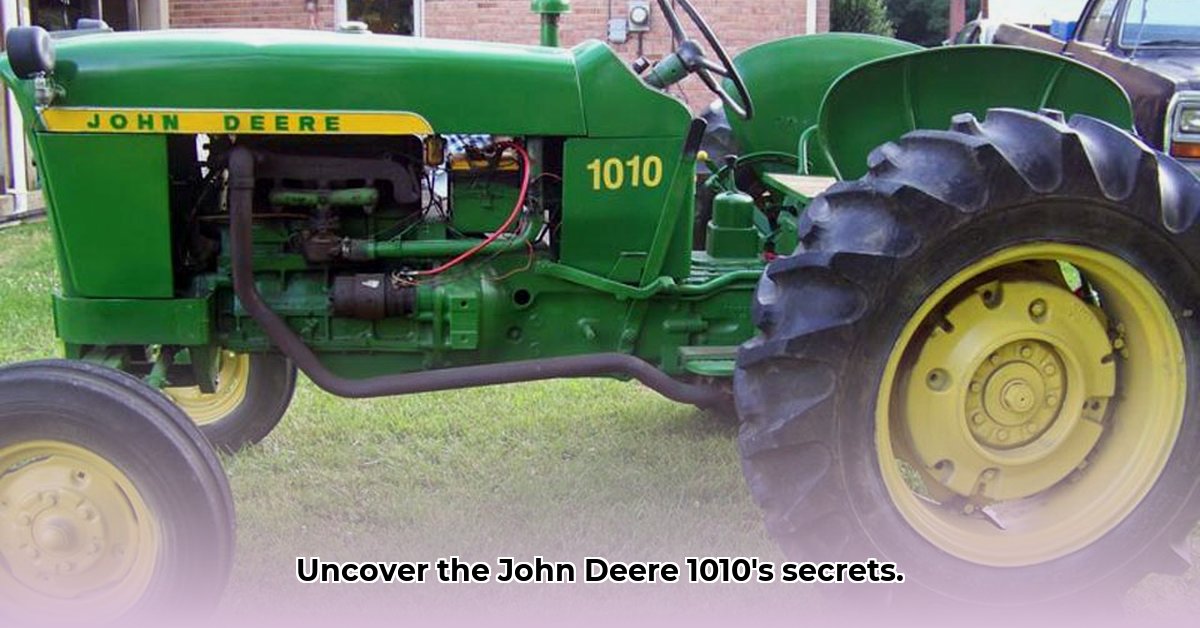
The John Deere 1010: While not the newest model, this tractor remains a compelling option for small-scale and sustainable farming operations. Its blend of simplicity, efficiency, and relatively low environmental impact makes it worthy of consideration. Let's explore its specifications and suitability for modern agricultural practices. For the latest models, check out new John Deere tractors.
Under the Hood: Engine and Power
The John Deere 1010 boasts a robust engine, typically a 2.4-liter diesel or a 1.9-liter gasoline engine, delivering approximately 36 horsepower. This power output is sufficient for various tasks on smaller farms, including tilling, cultivating, and light hauling. However, it's crucial to realistically assess your farming needs. Is 36 horsepower enough to meet your demands? For large-scale operations, a more powerful tractor might be necessary. Remember, horsepower requirements vary significantly based on the tasks and soil conditions.
Shifting Gears: Transmission and Drivetrain
The 1010 employs a simple sliding gear transmission, a manual gearbox requiring operator skill. While less convenient than modern automatic transmissions, this simplicity contributes to lower maintenance costs and easier repairs. Its two-wheel-drive (2WD) configuration prioritizes maneuverability, making it ideal for smaller fields and navigating obstacles. This design choice, prioritizing simplicity over complexity, is a key factor in its suitability for sustainable farming where ease of maintenance is highly valued. "The simplicity of the 1010's drivetrain is a significant advantage for smaller farms and those prioritizing sustainability," says Dr. Emily Carter, Agricultural Engineering Professor at the University of Illinois.
Size and Weight: Minimizing Environmental Impact
The John Deere 1010's compact size and relatively light weight minimize soil compaction. This is a crucial aspect of sustainable agriculture, preserving soil structure and long-term health. The precise weight can vary depending on the model year and added accessories, so always verify the weight of the specific tractor you are considering. However, its generally lighter design minimizes ground disturbance compared to larger, heavier tractors. This characteristic makes it particularly well-suited for organic farming and agroforestry systems.
Fuel Efficiency: Economic and Environmental Benefits
Compared to larger tractors, the John Deere 1010 exhibits relatively high fuel efficiency. Its smaller engine requires less fuel to complete tasks, resulting in cost savings and a smaller carbon footprint. While precise fuel consumption varies based on work performed and terrain, its efficiency contributes to lower operating costs and reduced environmental impact. This fuel efficiency represents a significant advantage for environmentally conscious farmers seeking to minimize their carbon footprint.
Maintenance and Repair: Simplicity as an Asset
The 1010's straightforward mechanical design simplifies maintenance and repair, reducing downtime and associated costs. Fewer electronic components translate to fewer potential points of failure. Although parts availability for older models might pose a challenge, readily available resources and the strong online community of John Deere enthusiasts provide support. This ease of maintenance is a significant factor contributing to the lower total cost of ownership and aligns well with the principles of sustainable farming.
The John Deere 1010 and Sustainable Farming: A Balanced Perspective
The John Deere 1010 represents a viable option for sustainable agriculture, particularly for small-scale operations. Its fuel efficiency and minimal soil compaction are key advantages aligning with environmentally conscious farming practices. However, its limited horsepower necessitates a realistic assessment of your farming needs. While its simplicity translates to lower repair costs, it may also mean more manual labor for repairs.
Key Considerations for Sustainable Farming with the John Deere 1010
- Fuel Efficiency: The 1010’s lower fuel consumption directly contributes to cost savings and reduced greenhouse gas emissions.
- Soil Health: Its lightweight design minimizes soil compaction, promoting healthy soil structure and long-term fertility.
- Maintenance Simplicity: Easier maintenance translates to reduced downtime and potentially lower repair bills. However, it may require more hands-on mechanical skills.
Remember: Thoroughly research and compare options before making any purchase. The suitability of a John Deere 1010 depends on your specific farming operation, budget, and available resources.